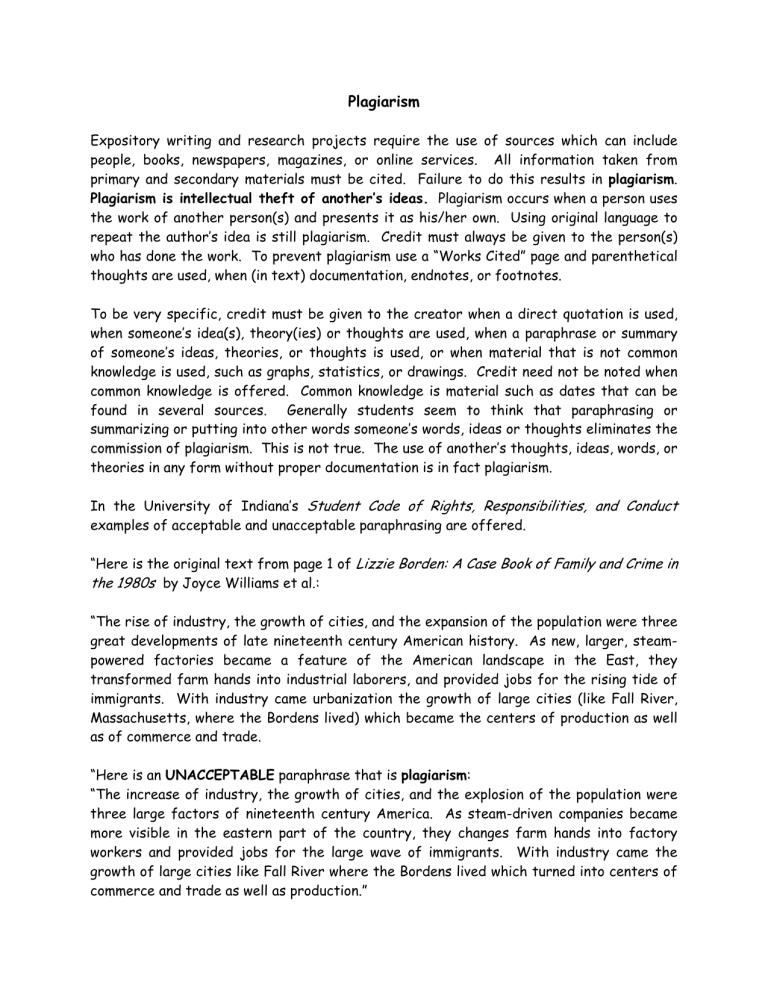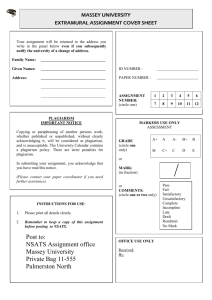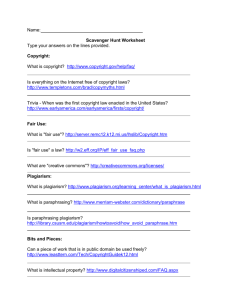Plagiarism

Plagiarism
Expository writing and research projects require the use of sources which can include people, books, newspapers, magazines, or online services. All information taken from primary and secondary materials must be cited. Failure to do this results in plagiarism .
Plagiarism is intellectual theft of another’s ideas.
Plagiarism occurs when a person uses the work of another person(s) and presents it as his/her own. Using original language to repeat the author’s idea is still plagiarism. Credit must always be given to the person(s) who has done the work. To prevent plagiarism use a “Works Cited” page and parenthetical thoughts are used, when (in text) documentation, endnotes, or footnotes.
To be very specific, credit must be given to the creator when a direct quotation is used, when someone’s idea(s), theory(ies) or thoughts are used, when a paraphrase or summary of someone’s ideas, theories, or thoughts is used, or when material that is not common knowledge is used, such as graphs, statistics, or drawings. Credit need not be noted when common knowledge is offered. Common knowledge is material such as dates that can be found in several sources. Generally students seem to think that paraphrasing or summarizing or putting into other words someone’s words, ideas or thoughts eliminates the commission of plagiarism. This is not true. The use of another’s thoughts, ideas, words, or theories in any form without proper documentation is in fact plagiarism.
In the University of Indiana’s
Student Code of Rights, Responsibilities, and Conduct
examples of acceptable and unacceptable paraphrasing are offered.
“Here is the original text from page 1 of
Lizzie Borden: A Case Book of Family and Crime in the 1980s
by Joyce Williams et al.:
“The rise of industry, the growth of cities, and the expansion of the population were three great developments of late nineteenth century American history. As new, larger, steampowered factories became a feature of the American landscape in the East, they transformed farm hands into industrial laborers, and provided jobs for the rising tide of immigrants. With industry came urbanization the growth of large cities (like Fall River,
Massachusetts, where the Bordens lived) which became the centers of production as well as of commerce and trade.
“Here is an UNACCEPTABLE paraphrase that is plagiarism :
“The increase of industry, the growth of cities, and the explosion of the population were three large factors of nineteenth century America. As steam-driven companies became more visible in the eastern part of the country, they changes farm hands into factory workers and provided jobs for the large wave of immigrants. With industry came the growth of large cities like Fall River where the Bordens lived which turned into centers of commerce and trade as well as production.”
The above paraphrasing is considered plagiarism because only a few words or phrases have been changed from the original, a source is not cited, and even the sense of some sentences is altered.
“Here is an ACCEPTABLE paraphrase:
“Fall River, where the Borden family lived, was typical of northeastern industrial cities of the nineteenth century. Steam-powered production had shifted labor from agriculture to manufacturing, and as immigrants arrived in the US, they found work in these new factories. As a result, populations grew, and large urban areas arose. Fall River was one of these manufacturing and commercial centers (Williams 1).”
This paraphrase is not plagiarism because the information is accurately stated in the writer’s own words, and the source of the material is stated. ( www.indiana,edu )
Students should read the section on “Academic Honesty” in the
NHS Student Handbook
(
See page 42). Students who have any questions about plagiarism should ask their teacher or the media specialist for further clarification.




